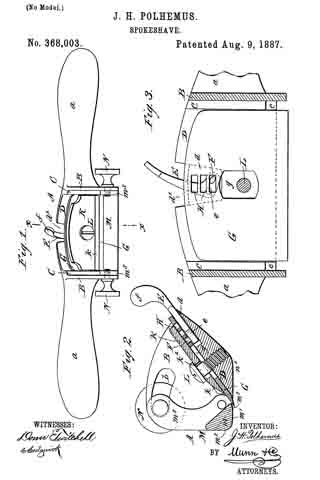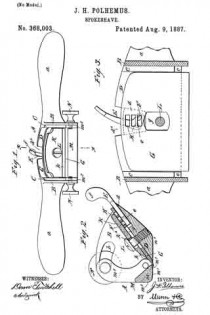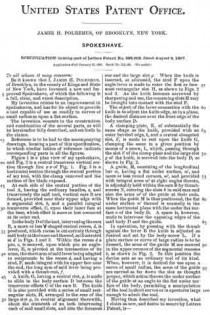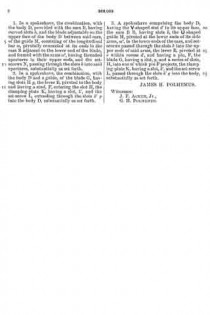
| PLEASE NOTE: The images presented on this page are of low resolution and, as a result, will not print out very well. If you wish to have higher resolution files then you may purchase them for only $2.95 per patent by using the "Buy Now" button below. All purchases are via PayPal. These files have all been cleaned up and digitally enhanced and are therefore suitable for printing, publication or framing. Each zip package contains all the images below (some packages may contain more), and purchased files can be downloaded immediately. |
UNITED STATES PATENT OFFICE.
_________________
JAMES H. POLHEMUS, OF BROOKLYN, NEW YORK.
SPOKESHAVE.
_________________
SPECIFICATION forming part of Letters Patent No. 368,003, dated August 9, 1887.
Application filed January 25, 1887. Serial No. 225,465. (No model.)
_________________
To all whom it may concern:
Be it known that I, JAMES H. POLHEMUS, of Brooklyn, in the county of Kings and State of New York, have invented a new and Improved Spokeshave, of which the following is a full, clear, and exact description.
My invention relates to an improvement in spokeshaves, and has for its object to provide a tool capable of use as readily in curves of small radius as upon a flat surface.
The invention consists in the construction and combination of the several parts, as will be hereinafter fully described, and set forth in the claims.
Reference is to be had to the accompanying drawings, forming a part of this specification, in which similar letters of reference indicate corresponding parts in all the figures.
Figure 1 is a plan view of my spokeshave, and Fig. 2 is a central transverse vertical section through line x x of Fig. 1. Fig. 3 is a horizontal section through the central portion of my tool, with the clamp removed and the surface of the blade exposed.
At each side of the central portion of the tool A, having the ordinary handles, a, and transversely the said tool, vertical ears B are formed, provided near their upper edge with a segmental slot, b, and a parallel integral transverse offset, C, upon their inner face at the base, which offset is more or less concaved at its outer end.
In the body D of the tool, intervening the ears B, a more or less V-shaped central recess, d, is produced, which recess is out entirely through said body at the inner end thereof, as illustrated at d’ in Figs. 1 and 3. Within the recess d a pin, e, is secured, upon which pin an angle-lever, E, is pivoted at the intersection of its arms, the short arm of said lever being adapted to reciprocate in the recess d, and having a stud, F, made integral with its upper face near the end, the long arm of said lever being provided with a thumb-rest, f.
A knife, G, having a central slot, g, is made to slide in the body surface D between the transverse offsets C of the ears B. The knife G is also provided with a series of small rectangular slots, H, arranged to the rear of the large slot g, in central alignment therewith, about the sixteenth of an inch intervening each of said small slots, and also the foremost one and the large slot g. When the knife is inserted, as aforesaid, the stud F upon the angle-lever is made to enter the first or foremost rectangular slot H, as shown in Figs. 2 and 3. As the knife becomes narrowed by sharpening and use, the remaining slots H may be brought into contact with the stud F.
The object of the lever-connection with the knife is to adjust the knife-edge, as in a plane, the desired distance over the front edge of the body surface D.
A clamping-plate, K, of substantially the same shape as the knife, provided with an outer beveled edge, k, and a central elongated slot, k’, is made to rest upon the knife G, clamping the same in a given position by means of a screw, L, which, passing through the slot k’ of the clamp-plate and the large slot g of the knife, is screwed into the body D, as shown in Fig. 2.
A guide, M, consisting of the longitudinal bar m, having a flat under surface, m’, and more or less round corners, m2, and provided with integral arms m3 at right angles thereto, is adjustably held within the ears B by thumb-screws N, entering the slots b in said ears and also the arms m3 of the guide at their ends. When the guide M is thus positioned, the flat under surface m’ thereof is normally in the same horizontal plane with the under flat surface n of the body D. A space is, however, made to intervene the opposing edges of the said body D and the guide.
In operation, by pressing with the thumb against the lever E the knife is adjusted as desired and set by the body-screw L. If a plain surface or curve of large radius is to be dressed, the arms of the guide M are secured in the upper corners of the segmental recesses b, as shown in Fig. 2. In this position the device acts as an ordinary tool of its kind. When, however, it is desired for use upon a curve of small radius, the arms of the guide are carried as far down the slot as thought proper, which action throws the under surface of the guide at an angle to the flat under surface of the body, permitting a manipulation of the tool in short curves or in apertures large enough to admit the tool.
Having thus described my invention, what I claim as new, and desire to secure by Letters Patent, is —
1. In a spokeshave, the combination, with the body D, provided with the ears B, having curved slots b, and the blade adjustable on the upper face of the body D between said ears, of the guide M, consisting of the longitudinal bar m, pivotally connected at its ends to the ears B adjacent to the lower end of the blade, and formed with the arms m3, having threaded apertures in their upper ends, and the set-screws N, passing through the slots b into said apertures, substantially as set forth.
2. In a spokeshave, the combination, with the body D and a guide, of the blade G, having slots H g, the lever E, pivoted to the body and having a stud, F, entering the slot H, the clarnping-plate K, having a. slot, k’, and the set-screw L, extending through the slots k’ g into the body D, substantially as set forth.
3. A spokeshave comprising the body D, having the V-shaped slot d’ in its upper face, the ears B B, having slots b, the U-shaped guide M, pivoted at the lower ends of its side arrns, m3, to the lower ends of the ears, and set-screws passed through the slots b into the upper ends of said arms, the lever E, pivoted at e within recess d’, and having a pin, F, the blade G, having a slot, g, and a series of slots, H, into one of which pin F projects, the clamping-plate K, having a slot, k’, and the set-screw L, passed through the slots k’ g into the body, substantially as set forth.
JAMES H. POLHEMUS.
Witnesses:
J. F. ACKER, Jr.,
G. H. POLHEMUS.



